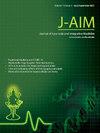Complete healing of a Dooshivishajanya non-healing wound with Jalaukavacharana - A case report
IF 1.9
Q3 INTEGRATIVE & COMPLEMENTARY MEDICINE
引用次数: 0
Abstract
A 35-year-old male patient, who is non-diabetic, non-dyslipidemic, normotensive, and euthyroid, and works as a hotel manager, visited our outpatient department with complaints of two ulcers on the inner side of his right lower leg, which developed rapidly after intense itching for about a week due to scratching. The ulcers were clean, had granulation tissue, caused mild pain, showed no discharge, and were surrounded by dark discolouration. The patient's history indicated that he had experienced severe itching in that area for four to five years, along with recurrent fevers, which began after being bitten by an unidentified type of black ant. The Bates Jensen wound assessment tool scored 33 for the larger wound and 27 for the smaller wound. Initially, the patient received some Ayurvedic treatments aimed at promoting healing for approximately 40 days, but these did not improve. A venous Doppler ultrasound of his right leg indicated chronic venous insufficiency. Given the persistent nature of the ulcers despite medical treatment, the condition was diagnosed as Dooshi Vishajanya Vrana over chronic venous insufficiency. Therefore, a single session of Jalaukavacharana was performed using three Jalaukas on the ulcer site, which healed within one week of the treatment. After the treatment, the Bates Jensen wound assessment scores improved to 18 for the larger wound and 17 for the smaller wound. Follow-up evaluations conducted after four months and one year revealed no recurrence of the ulcers. The dark discolouration of the leg began to diminish from the fourth month of the follow-up period.
用Jalaukavacharana完全治愈Dooshivishajanya未愈合伤口1例报告
患者男,35岁,无糖尿病,无血脂异常,血压正常,甲状腺功能正常,酒店经理,就诊于我门诊,主诉右小腿内侧两处溃疡,因抓挠引起剧烈瘙痒约一周后迅速发展。溃疡干净,有肉芽组织,引起轻度疼痛,无分泌物,周围有深色变色。病人的病史表明,他在被一种不明类型的黑蚂蚁咬伤后,该区域出现了4到5年的严重瘙痒,并伴有反复发烧。Bates Jensen伤口评估工具对较大的伤口评分为33分,对较小的伤口评分为27分。最初,患者接受了一些旨在促进愈合的阿育吠陀治疗,持续了大约40天,但并没有改善。右腿静脉多普勒超声显示慢性静脉功能不全。尽管进行了药物治疗,但溃疡仍持续存在,病情被诊断为慢性静脉功能不全。因此,在溃疡部位使用三个Jalaukas进行一次Jalaukavacharana,溃疡在治疗一周内愈合。治疗后,大创面的Bates Jensen创面评分为18分,小创面评分为17分。四个月和一年后的随访评估显示溃疡没有复发。从随访的第四个月开始,腿部的深色变色开始减少。
本文章由计算机程序翻译,如有差异,请以英文原文为准。
求助全文
约1分钟内获得全文
求助全文
来源期刊

Journal of Ayurveda and Integrative Medicine
INTEGRATIVE & COMPLEMENTARY MEDICINE-
CiteScore
4.70
自引率
12.50%
发文量
136
审稿时长
30 weeks
 求助内容:
求助内容: 应助结果提醒方式:
应助结果提醒方式:


